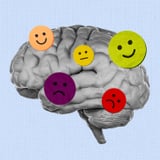A Therapist's Guide to Understanding Not Shaming Your Emotions
 Get the Full StoryMany of us grow up learning to suppress our feelings instead of understanding them. We're taught to "toughen up" or to prioritize productivity or practicality over emotional well-being. But the truth is, understanding and managing our emotions is one of the most powerful tools for creating a meaningful and fulfilling life. When you can make sense of your emotions, you approach life through a proactive approach, instead of a reactive one.
Get the Full StoryMany of us grow up learning to suppress our feelings instead of understanding them. We're taught to "toughen up" or to prioritize productivity or practicality over emotional well-being. But the truth is, understanding and managing our emotions is one of the most powerful tools for creating a meaningful and fulfilling life. When you can make sense of your emotions, you approach life through a proactive approach, instead of a reactive one.If you're ready to make sense of your big feelings and use emotional awareness to live better, here are some steps to help you get started.
Name, don't shame, your emotions.
One of the most transformative steps in gaining emotional clarity is learning to name your emotions without shaming yourself for having them.
Emotions are natural responses to our internal and external environments, and they last for 90 seconds in the brain. Emotions are not moral judgments about who we are, but many of us have been conditioned to label certain emotions - like anger, sadness, or fear - as "bad" or "weak." We shame ourselves for even experiencing them. This shame prevents us from fully processing what we feel and what to do to feel better.
Whatever you're experiencing whether it's frustration, disappointment, joy, or grief - it's valid. Start by giving yourself permission to feel. Instead of saying, "I shouldn't feel this way," try saying, "I notice I feel ___." This shift creates space for curiosity instead of judgment, allowing you to explore the root of the feeling and what it might be telling you.
Remember, there's no such thing as a "wrong" emotion. You are not responsible for your emotions, because they occur naturally; you are responsible for how you act in response to them.
Connect with your body.
Emotions don't only happen in your mind, even though they originate there. An emotional reaction has a physical response in your body. The next time you feel a strong emotion, pause and do a quick body scan. Ask yourself: "What sensations am I experiencing? Where am I holding tension or discomfort?" By connecting with these physical cues, you can build a deeper understanding of your emotional landscape.
This also helps you anticipate certain emotions in certain situations. If you can recognize the red flags of a difficult emotion in your body, you can then utilize practices such as deep breathing, grounding, or movement to manage the emotion physically.
Your emotions are messengers; are you listening?
Your emotions are trying to tell you something. Anger might signal a boundary that's been crossed, while sadness could indicate an unmet need. If you're feeling drained after spending time with someone, it might be a sign to reevaluate that relationship. Or if a particular activity sparks joy, consider how you can make more space for it in your life. By viewing your emotions as messengers instead of a nuisance, you can start to use them to guide your decisions.
Learning to navigate emotions doesn't mean avoiding difficult feelings; it means building resilience to face them. Your emotions are not your enemy - they're your allies. They're there to guide you, inform you, and help you live a life that feels true to who you are.
Israa Nasir is a New York City-based psychotherapist and author of "Toxic Productivity: Reclaim Your Time and Energy in a World That Always Demands More." Israa received her undergraduate degree in psychology at the University of Toronto and her master's in counseling at Adelphi University in New York. She is also certified in cognitive behavior therapy and rational emotive behavioral therapy. Israa is a PS Council member.
Share: